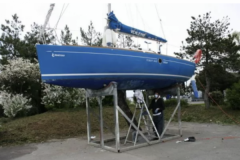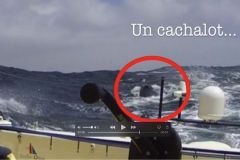It's easy to forget that, but the life of a boat is not just about its use. It has to be built (logically) with raw materials, then transported to its place of delivery, used and one day disposed of. All these steps summarize its life cycle, and each of them can be studied in order to quantify greenhouse gas emissions in tons of CO2 emitted.
Construction and disposal: it gets stuck

To build a sailboat or motorboat hull, synthetic fibres and chemical resins are king. To be manufactured, glass and carbon fibres are heated to extremely high temperatures, with a significant energy cost. The resins, on the other hand, come from petrochemical processes and are harmful to health and the environment. The manufacture of moulds is also to be taken into account, and it is better to use it several times, at the risk of seeing its environmental balance sheet soar! Mast, boom, engine, rudders, keel, fittings of all kinds: all these elements are made from raw materials, manufactured and transported to the construction site, also emitting carbon dioxide.
Once the boat is finished, it is taken to its home port. The pollution emitted during its use phase is easier for boaters to understand - and to control: maintenance, engine use, refuelling, household waste, etc

And one fine day, after (very) long years of good and loyal service, the boat comes to the end of its life. Who hasn't taken the time to look at the dying ships in the harbours? Covered with algae, rust, mould, they are hard to see and one would sincerely prefer that they be disposed of "for their own good". The APER (Association pour la Plaisance EcoResponsable) has been entrusted with the task of managing the treatment of pleasure boats in 2018, with the objective of 5,000 deconstructed boats per year. In 2019, it was struggling to reach 8% of the target set. Why so few results? Is it perhaps due to ignorance of this new service, or is it due to the cost of transport, at the owner's expense, to take the boat to one of the 24 deconstruction centres?
Awareness

Certainly, to implement change most effectively, models and examples with a voice are needed. Several ocean racing skippers (Roland Jourdain, Stanislas Thuret, Arthur Le Vaillant...) have decided to act on their own scale and to come together around an association called "La Vague", in reference to the wave that propagates at sea. Their objective is to question their sport from all angles: the design of the yachts, the organisation of events, the communication. Although discreet for the moment, this structure has the merit of putting its finger on a topical issue and taking part of the responsibility.
Is it therefore utopian to imagine a cleaner water sport? Reading these lines, it seems obvious that the best way to reduce its environmental footprint would be ... not to build boats and to use existing ones instead. But this would be a real hassle for creative and entrepreneurial minds! It would perhaps be more interesting to carry out actions "in conscience" so as not to lose the pleasure of sailing: maintain your boat in a shipyard that collects and treats waste water, contact the APER to dispose of your boat, think about reusing sails and ropes..
These new themes of sustainable development, although distressing and constraining, are also a tremendous opportunity to reinvent boating to imagine the world of tomorrow. And as a famous Chinese sage once said: "A journey of a thousand miles always begins with a first step. ». So let's dare to take that first step, however ridiculous we think it is, it's already a step in the right direction!















